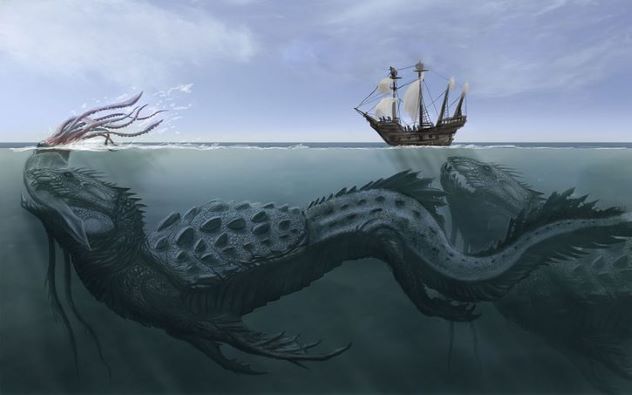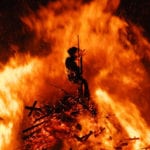 Technology
Technology  Technology
Technology  Humans
Humans 10 Everyday Human Behaviors That Are Actually Survival Instincts
 Animals
Animals 10 Animals That Humiliated and Harmed Historical Leaders
 History
History 10 Most Influential Protests in Modern History
 Creepy
Creepy 10 More Representations of Death from Myth, Legend, and Folktale
 Technology
Technology 10 Scientific Breakthroughs of 2025 That’ll Change Everything
 Our World
Our World 10 Ways Icelandic Culture Makes Other Countries Look Boring
 Misconceptions
Misconceptions 10 Common Misconceptions About the Victorian Era
 Mysteries
Mysteries 10 Strange Unexplained Mysteries of 2025
 Miscellaneous
Miscellaneous 10 of History’s Most Bell-Ringing Finishing Moves
 Technology
Technology Top 10 Everyday Tech Buzzwords That Hide a Darker Past
 Humans
Humans 10 Everyday Human Behaviors That Are Actually Survival Instincts
 Animals
Animals 10 Animals That Humiliated and Harmed Historical Leaders
Who's Behind Listverse?

Jamie Frater
Head Editor
Jamie founded Listverse due to an insatiable desire to share fascinating, obscure, and bizarre facts. He has been a guest speaker on numerous national radio and television stations and is a five time published author.
More About Us History
History 10 Most Influential Protests in Modern History
 Creepy
Creepy 10 More Representations of Death from Myth, Legend, and Folktale
 Technology
Technology 10 Scientific Breakthroughs of 2025 That’ll Change Everything
 Our World
Our World 10 Ways Icelandic Culture Makes Other Countries Look Boring
 Misconceptions
Misconceptions 10 Common Misconceptions About the Victorian Era
 Mysteries
Mysteries 10 Strange Unexplained Mysteries of 2025
 Miscellaneous
Miscellaneous 10 of History’s Most Bell-Ringing Finishing Moves
10 Reasons to Stay Away from Large Bodies of Water
People fork over huge sums of money to live in a place with a view over the water, whether it be the ocean, a bay, a lake, a lagoon, or a fjord. There is something inherently magical about waking up to the sun glittering over the sea or watching as thick mist rolls in over a lake.
But what if you’re gazing out at the water, feeling all kinds of peace, just to see a shadowy figure staring back at you? Or you hear someone humming a long-forgotten tune while you’re strolling along the shore, and you find yourself face to face with a red-eyed mermaid ready to stick sharp claws into your flesh.
Water mythology has been around for a very long time and centers around a slew of scary characters and fabled objects. On this list are just a few of these.
Related: Top 10 Cryptids You’ve Never Heard Of
10 Burning Ship of the Northumberland Strait
If you’re not familiar with Canadian topography, Prince Edward Island, New Brunswick, and Nova Scotia aren’t places you would likely recognize. Unless you’ve read L. M. Montgomery’s acclaimed Anne of Green Gables, that is.
However, the Northumberland Strait, located between PEI, New Brunswick, and Nova Scotia, has put Canada on the paranormal map, as opposed to the literary one.
In 1900, a group of sailors from Charlottetown spotted a ship sailing toward the shore. As the ship drew near, the sailors saw her masts crawling with crew members trying to escape an inferno on the deck. The sailors sprang into action, jumping into a rowboat and oaring toward the burning ship. Just before they reached it, the ship disappeared before their eyes.
This wasn’t the first sighting of the ship. Reports have been trickling in since 1786, and the legend of the burning schooner has served as inspiration for novels, articles, and songs. It even has its own dedicated Canadian postage stamp.
A couple in Glengarry also saw the ship one evening in 1950, fully rigged and engulfed in flames, sailing down the Northumberland Strait. Unlike most urban legends, there is no backstory to this phenomenon. No sinking or tragedy that could have given rise to this eerie story. Instead, those who live in the area just try to keep an eye out for the burning ship and cross their fingers against bad luck.[1]
9 Flathead Lake Monster
Scotland is not the only place that boasts a water-dwelling monster. Flathead Lake in Montana falls within the boundary of the Confederated Salish and Kootenai Tribes Flathead Reservation and is the largest natural freshwater lake west of the Mississippi in the lower forty-eight states.
In 1889, the skipper of the U.S. Grant steamboat and several passengers spotted what seemed to be a huge log in the waters of Flathead Lake. As they approached the object, they realized it was a living creature. It was coming toward them and moving fast. One passenger fired at it with a rifle but missed. And so was born the legend of the Flathead Lake Monster.
Those who have encountered the monster describe it as a massive eel-shaped creature of up to forty feet (12.2 meters). Some say it looks like a giant sturgeon with a head like a bowling ball. There have been many more sightings over the years, and the monster has earned the nickname “Flessie.”
In a strange turn of events, a three-year-old boy who couldn’t swim was found soaking wet at the end of a dock at the lake in 2017. When he was asked what had happened to him, he said that he’d fallen into the lake and a monster had lifted him up and out to safety.[2]
8 Miniwashitu
In 1921, curator Melvin Randolph Gilmore wrote about a creature named Miniwashitu. This mysterious being was allegedly seen in the Missouri River, glowing like fire and producing an unearthly sound. Soon people began believing that those who saw the beast in the daytime would become inflicted with insanity and unexplained physical pain.
The monster is said to have red hair and one eye in the middle of its forehead, with a horn protruding above it. Its backbone looks like a giant saw.
Even in modern times, Missouri locals still tell the story of the Miniwashitu. It is believed that the monster still lurks in the river and moves upstream during springtime. Sometimes it moves around in winter, breaking ice that has formed over the water.[3]
7 Ashrays
There is more to Scotland than just unicorns and the Loch Ness Monster. Here you might just bump into what looks like an underwater ghost known as an Ashray. Ashrays cannot live on land and are only found beneath the water’s surface. They resemble the ghosts of humans, as they are entirely translucent, and the best time to look for them is, of course, in the dark of night as they are nocturnal creatures.
In English folklore exists the Asrai, which is supposed to be an aquatic fairy. Legend has it that a fisherman once captured an Asrai and put it in his boat. The Asrai pleaded with the fisherman in a language he could not understand, but the fisherman proceeded to tie wet weeds around the fairy, burning his hands in the process when he touched its skin. Eventually, the Asrai melted into a puddle of water. It is believed that these creatures perish if exposed to the sun for too long.
They are said to have green hair and a mermaid-like fishtail. They only come up to the surface once every hundred years to bathe in the moonlight.[4]
6 Spiteful Mermaid
Most people have heard of the so-called “water babies” found in lakes and rivers in America. Urban legend says that ancient members of the Paiute Tribe would drown disabled babies in bodies of water, only for the babies to return in spirit form and cry out over the water when night falls.
Pyramid Lake in Nevada is not only one of the locations where the wail of water babies has been heard, but it is also where a brokenhearted mermaid is believed to have spoken a curse after her marriage to a Paiute Tribe member was frowned upon. She was banished from the land and, in turn, vowed revenge should any tribe members go anywhere near the lake. To this day, many Paiute members still believe that any bad luck suffered by the tribe can be attributed to the mermaid’s curse.
Perhaps the scariest part of Pyramid Lake is that it is the last remnant of the ancient Lake Lahontan, and it was also the deepest part. This means that no one really knows what lies in the sediments far below.[5]
5 Ship of Death
In 1862, Leon Webber watched as a veil of mist enveloped the Platte River in Wyoming. He moved closer to the river’s edge and, out of curiosity, tossed a small stone at the mist. It instantly transformed into a ship covered in frost.
Webber could only stare as several sailors onboard, who were also covered in frost, closed ranks around an object lying on the deck. When they scattered, Webber saw that the object was the body of a young woman. Then with a shock, he realized he was looking at his own fiancé.
Trying to push the experience from his mind, Webber returned home a month later only to find that his fiancé had died on the very same day he’d seen the vision of her corpse.
Since then, the aptly nicknamed Ship of Death has been sighted every 25 years. Creepily, all the sightings are reported to have taken place in the middle of the day, when temperatures usually soar, which makes it somewhat more difficult to explain away the thick, rolling mist and the shadows some witnesses have seen form over the water.[6]
4 Hafgufa

An Icelandic legend has it that a ginormous sea monster named Hafgufa once existed in the Greenland sea. The monster was said to be a massive fish whose top part resembled an island. Sightings of Hafgufa were rare, but a sailor once witnessed her belch and expel a huge amount of food which attracted thousands of fish. The fish crowded into Hafgufa’s mouth, and she swallowed them all in one go.
It is believed that Hafgufa was the mother of all sea monsters and ate anything she could catch, including ships, humans, and whales. Because she resembled an island, many sailors would mistake her nose and head, which she raised above the surface at low tide, for rocks.[7]
3 The Octavius
In 1761, the Octavius docked in the port of London and took on cargo destined for China. The ship left London with a full crew on board, as well as the family of the captain. They made the trip safely to China, and once they took on cargo meant to be offloaded in Britain, the captain decided to sail the Northwest Passage. After entering the passage, the ship vanished without a trace.
Fast forward to 1775. The whaling ship, Herald, was sailing the waters of Greenland when her crew saw another ship a distance away. As they sailed closer to the ship, they saw that she was in bad shape. Some of the crew boarded the vessel to investigate and made a horrific discovery below deck. In the crew’s quarters, all 28 crew members of the Octavius were found in a frozen state. The captain was seated at his desk, frozen to his seat. Behind him were his wife and son, both frozen.
The Herald crew members were shocked and terrified. They grabbed the ship’s log and fled. In their haste, the book’s middle pages loosened and were lost. What remained of the writing in the logbook told the story of the ship becoming stuck in the Arctic ice near Barrow, Alaska. Fearing that the Octavius was cursed, the crew of the Herald simply let it drift off. It was never seen again and might still be floating in the open water somewhere, its unlucky passengers still onboard.[8]
2 Lorelei
On the echoing rock, Lurlei, on the southern bank of the River Rhine, you might just spot Lorelei. German lore tells the story of a woman who had been betrayed by her lover. Her heart shattered, she drowned herself in the river and was reincarnated into a siren. The murmuring echo that emanates from Lurlei is said to be Lorelei’s song, calling men onto the rocks and their subsequent doom.
Heinrich Heine wrote a poem called “Die Lorelei” in 1824, which has since been set to music by several composers.
“The comb she holds is golden,
She sings a song as well
Whose melody binds an enthralling
And overpowering spell.
In his little boat, the boatman
Is seized with a savage woe,
He’d rather look up at the mountain
Than down at the rocks below…”[9]
1 The Celtic Merrow
Ireland is steeped in folklore. Here you will hear tales of wailing banshees, mischievous leprechauns, and creepy fairies. It is also the place you’ll find the Celtic merrow who used to live in the Celtic seas according to legend.
A merrow is a mermaid with a magical cap that enables her to travel between the sea and the shore. When the merrow combed her soft hair, sailors and fishermen were entranced. The comb used was of the magical variety and a symbol of feminine power.
The merrow is said to be either male or female, with the difference being that the women were exceptionally beautiful, but the men were hideously ugly. The merrow men became bitter when the women looked toward human men for mates. They resorted to capturing sailors and keeping them imprisoned underwater in revenge.
Should a male human wish to keep one of the merrow women with him on land, he would need to take away her magical cap before she could enchant him by singing. Possessing her cap meant the man would eventually be able to persuade her to marry him as well. However, the couple’s wedded bliss would be short-lived, as the merrow woman would search until she found her cap and then drag her husband underneath the waves with her.[10]








